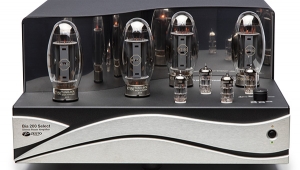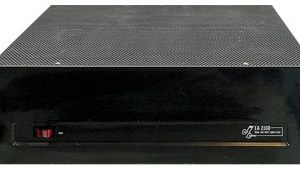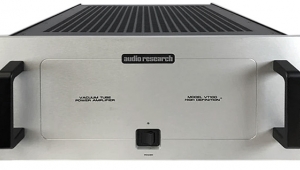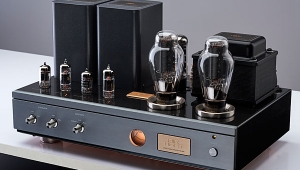| Columns Retired Columns & Blogs |
Wavac SH-833 monoblock power amplifier
Leaving aside for a moment the fact that the Wavac SH-833 costs $350,000/pair—
Okay, you can't leave it aside. Neither can I. They cost $350,000, fer chrissakes! Can any pair of amplifiers possibly be worth that? What's inside those boxes that could possibly make them cost $350,000? Will anyone actually pay $350,000 for a pair of 150W amplifiers?

Yes, $350,000 is a great deal of money to pay for a pair of amplifiers. In fact, it's a great deal of money to pay for a luxury car: you could buy an Aston-Martin Vanquish and pocket around 100 grand. It's a fair price for a small summer home, but it won't buy you much, if anything, painted by Picasso, which anyway would just hang on the wall and do nothing. You could probably hang a copy of a Picasso on the wall and be able to derive an equal amount of pleasure from it, and few would know the difference.
Yet people pay millions for a Picasso. From that perspective, these $350,000 amplifiers are a bargain. You could set up a 5.1-channel surround-sound system based on SH-833s for less than the cost of some Picassos. They'd play music and, in winter, heat your listening room and save you some money.
There's nothing outrageous about spending a million bucks on a painting or a vintage automobile. Nor is there anything wrong with dropping 350 big ones on a pair of amplifiers—as long as you're not robbing banks or selling your sister into slavery to raise the cash. Car buffs and art collectors never complain about astronomical prices, but it seems audiophiles have a big problem with such a genuine luxury good as a $350,000/pair of amplifiers.
Mention a $1000 turntable to an audiophile—even a digital-only one—and he won't blink. Mention a $1000 'table to your average "a-Bose-Wave-Radio-equals-room-filling-sound" kinda guy and his look says "$1000 for a what?"
When tmh's Jim Ricketts asked me if I wanted to review this eight-box assemblage, the first thing I did was laugh at the ludicrousness of the situation. Then I said, "Why the hell not?"
It's all relative.
Wavac and the SH-833
Wavac is a subsidiary of Sigma Co., Ltd., a relatively large Japanese industrial concern that, as far as I could gather, is involved in large-scale road building. Someone far up the chain of command must be an audio enthusiast—clearly, Wavac has access to the designing and building tools necessary to turn out a stunning-looking jewel of a product.
Wavac has been around for a decade, building single-ended triode (SET) amplifiers based on circuitry developed by the late Nobu Shishido and earning rave reviews from audio publications around the world. Shishido's work is carried on today by Yuzuru Ito, a sound engineer, music lover, and major fan of vacuum-tube amplification. One of the keys to Shishido's original design is the use of Inverted Interstate Transformer Coupling (IITC), which does away with the capacitors usually used to couple the input and driver tubes, in this case a 6550 or KT88 driving a cool-looking but warm-running 833 transmitter tube. The result, according to Wavac, is supposed to be "clear and full bass sound." That's a good start for $350,000. We all want that, and most of us think we can get it for a lot less than you-know-how-much.
Wavac claims there are no capacitors in the SH-833's circuit [I actually counted four in the amplifier chassis, two of which do appear to be in the audio circuit—JA.], which runs in class-A and is claimed to deliver 150W, with a frequency range of 20Hz-100kHz—an unusually high power output and wide bandwidth for a SET amp. Let's hope JA's measurements support those claims.
Each SH-833—that is, each channel—comprises four boxes. The floorstanding IS-833 is a big-ass isolation transformer on wheels. These boys were serious about providing pure juice to the power supply when they ordered that thing from Denkenseiki Laboratory and installed it in a chassis of substantial sculpted metal plate (not sheet metal). An identical chassis contains the TB-833 power transformer, which is bigger than most power amplifiers and sits atop the IS-833. The TB-833 includes five separate sets of taps, one for each of the amplifier's power circuits. A circular, chrome-plated On/Off button and a series of monitoring LEDs are set into the box's front panel.
A second, shorter stack comprises a smaller black box, the PS-833, which contains the rest of the power supply. It, too, is bigger than most power amplifiers. At one point during the installation, designer Yuzuru Ito opened it (he'll install them at your house, too, if you order a pair). Inside, along with a capacitor bank, solid-state diodes, and some other stuff, I spotted a series of chokes near the bottom that were bigger than the transformers you find in most power amps. The front of the chassis has a series of LEDs next to a rectangular LCD screen that monitors the power-up procedure and counts down the seconds until you can play music. When the mute circuit cuts off, the screen announces "Let's Enjoy!" Let's hope so.
Atop the PS-833 sits the SH-833 proper, resting on cones ringed with a proprietary white goopy material. The chassis is smoothly machined from a solid chunk of 60mm-thick aluminum that's anodized satiny champagne. The tube sockets are machined from Teflon, and feature gold-plated pins of phosphor bronze. The anode caps atop the 833 tubes are heavy brass with Teflon outer shells, and a thick sheet of solid Teflon provides a mounting surface for the internal posts for the hard-wired circuit, comprising metal-encased, non-inductive power resistors. [These are not exotic types but sourced from RS in the UK—Ed.] The circuit looks deceptively simple, with all point-to-point silver wire. And, of course, under the tall, chromed cover at the back of the amplifier chassis is a really large output transformer that is also bigger than a you-know-what.
In short, the SH-833 crawls with expensive, ultra-high-quality, custom-wound transformers. An ALPS potentiometer mounted on the amp's front panel lets you attenuate the volume if necessary. Through his translator, Yuzuru Ito assured me that the pot did not affect the sound, and that I could set it anywhere in its adjustment range and get equally fine sound.
Connections are made behind the output transformer cover. Two industrial-grade umbilicals attached to multi-pin connectors coming from the outboard PS-833 supply feed power to the amplifier's rear panel. In between are RCA and XLR inputs (the XLRs are for convenience only; the SH-833's input is single-ended) and three oversized speaker terminals: ground, and 4 and 8 ohm output transformer taps. Wavac uses the same steroidal binding posts I complained about in my December 1999 review of Musical Fidelity's Nu-Vista 300 power amp. The difference is that Wavac has machined the posts to more easily accommodate standard spade lugs.
The stacks look impressive, in an industrial sort of way—except for the main attraction, the tube-bearing SH-833 itself. The two mirror-imaged chassis, with their satiny finishes and curved glass shields inspire lust. At night, the tubes fired up and glowing in a darkened room, that lust is consummated.
- Log in or register to post comments



































